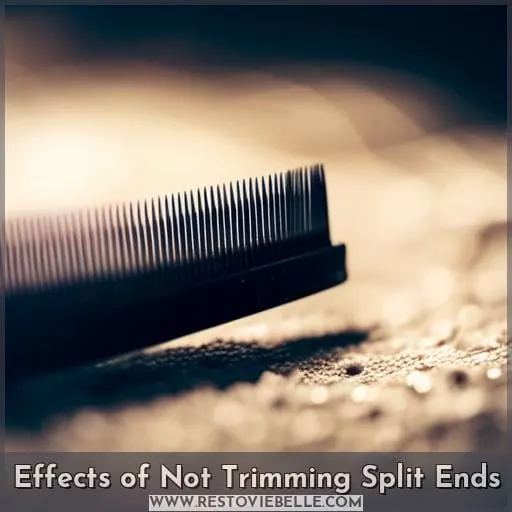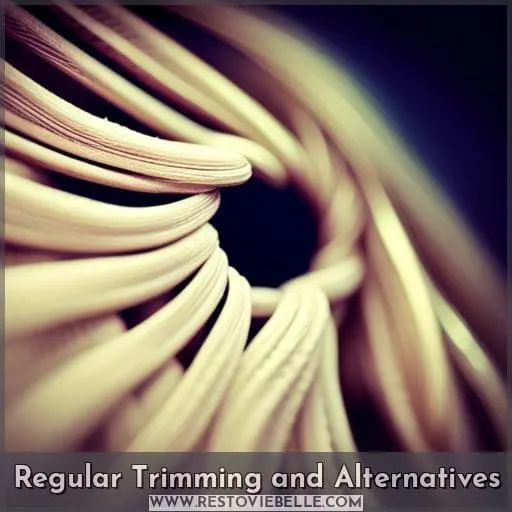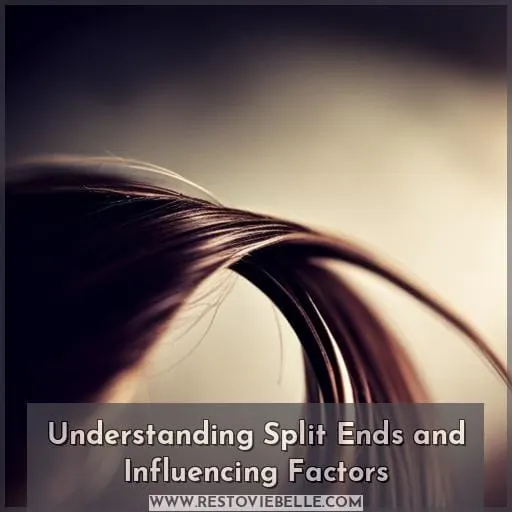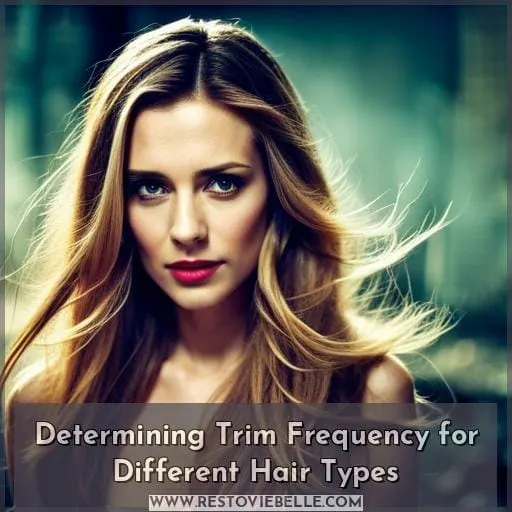This site is supported by our readers. We may earn a commission, at no cost to you, if you purchase through links.
 Imagine if you could skip the hair salon and still have healthy, beautiful locks.
Imagine if you could skip the hair salon and still have healthy, beautiful locks.
Contrary to popular belief, neglecting those pesky split ends doesn’t necessarily weaken or make your hair fall out. In fact, personal experiences and cultural examples challenge the necessity of frequent trims for hair growth.
Find out more about the unexpected consequences of not trimming split ends in this article.
Table Of Contents
- Key Takeaways
- Effects of Not Trimming Split Ends
- Lack of Trimming Doesn’t Necessarily Weaken or Make Hair Fall Out
- Personal Experiences and Cultural Examples Contradict the Necessity of Trimming for Hair Growth
- Hair Length Can Be Maintained Without Frequent Trims if Treated Gently
- Overly Focusing on Splits for Trimming Can Be Distracting and Unnecessary
- Personal Experience and Cultural Examples
- Six Years Without Trimming Demonstrated No Adverse Effects on Hair
- Cultures Like Sikh, Apostolic, and Yao Women Grow Exceptionally Long Hair Without Regular Trims
- Long Hair Growth Isn’t Hindered by the Absence of Trimming in These Cultural Practices
- Demonstrates That Minimal to No Trimming Doesn’t Impede Hair Health or Growth
- Supports the Idea That Minimal Trimming Aligns With Natural Hair Growth
- Understanding Dead Ends and Their Treatment
- Regular Trimming and Alternatives
- Regular Trims Maintain a Thick, Healthy-looking Hemline
- Lack of Trims Often Results in Fairy Tale Ends or a Tapered Hemline
- Damage Leading to Splits Can Occur at Various Hair Lengths, Not Just Ends
- Attempting to Trim Every Split Can Become Overwhelming and Impractical
- Search and Destroy (SD) Method Offers an Alternative to Frequent Trims by Targeting Split Ends Individually
- Considerations and Personal Impact
- Impact of Split Ends May Vary Based on Hair Type and Thickness
- Slight Splits Might Be More Visible on Thinner or Lighter Hair, Resembling Frizz
- Emphasizes the Need to Discern Individual Hair Needs Over Universal Rules
- Personal Update Highlights Potential Downsides of Never Trimming (uneven Lengths)
- Suggests Regular Trims May Contribute to a Neater Appearance but Might Impede Length Gains
- Understanding Split Ends and Influencing Factors
- Split Ends Stem From Hair Shaft Wear and Tear
- Exposure to Elements and Daily Habits Impact Hair Health
- Hair Typically Grows Half an Inch Monthly
- Factors Like Environmental Elements, Heat Styling Tools, Chemical Treatments, and Lack of Conditioning Contribute to Split Ends
- Vigorous Hair Brushing Can Also Cause Split Ends
- Determining Trim Frequency for Different Hair Types
- Frequently Asked Questions (FAQs)
- How often should I trim my hair if I have fine, curly hair?
- Can split ends lead to hair breakage and thinning?
- Are there any alternatives to regular trims for maintaining healthy hair?
- How can I determine if I have split ends or just frizzy hair?
- Is it possible for split ends to repair themselves without trimming?
- Conclusion
Key Takeaways
- Lack of regular trimming does not necessarily weaken or make hair fall out.
- Neglecting regular trims could potentially lead to uneven lengths and impede progress in achieving longer hair.
- Damage leading to splits can occur at various hair lengths, not just ends.
- There are alternatives to regular trims for maintaining healthy hair, such as using deep conditioning masks, limiting washing, opting for clarifying shampoo, and using silk pillowcases to minimize damage.
Effects of Not Trimming Split Ends
When it comes to not trimming split ends, there are some surprising effects to consider.
Contrary to popular belief, not trimming your split ends doesn’t necessarily weaken or make your hair fall out. In fact, personal experiences and cultural examples have shown that you can maintain your hair length without frequent trims if you treat it gently.
It’s important to remember that overly focusing on splits for trimming may be distracting and unnecessary in the long run.
Lack of Trimming Doesn’t Necessarily Weaken or Make Hair Fall Out
Not trimming split ends doesn’t necessarily weaken or make your hair fall out. Contrary to popular belief, maintaining the health of your hair can be achieved without frequent trims.
- Hair strength and growth myths debunked
- Trimming misconceptions and natural resilience of hair
- Cultural practices that challenge traditional split end prevention
Personal Experiences and Cultural Examples Contradict the Necessity of Trimming for Hair Growth
Contrary to popular belief, personal experiences and cultural examples challenge the necessity of regular trimming for hair growth. Cultural practices and individualized haircare routines debunk growth misconceptions and longevity myths surrounding split end management.
Hair Length Can Be Maintained Without Frequent Trims if Treated Gently
You can maintain your hair length without frequent trims if you treat it gently.
By implementing gentle treatments, such as using heat protectants and avoiding harsh styling techniques, you can promote growth maintenance and effectively manage split ends while retaining your desired hair length.
Overly Focusing on Splits for Trimming Can Be Distracting and Unnecessary
Instead of constantly fixating on split ends, take a more balanced approach to hair care.
Explore trim alternatives, prioritize overall hair health, and embrace styling strategies that promote healthy growth.
Consider cultural insights and dispel common growth myths for optimal hair maintenance.
Personal Experience and Cultural Examples
When it comes to the effects of not trimming split ends, personal experiences and cultural examples offer valuable insights.
For instance, individuals who’ve gone without trimming their hair for extended periods have reported no adverse effects on their hair health or growth.
Additionally, cultures like Sikh, Apostolic, and Yao women are known for growing exceptionally long hair without regular trims.
These examples demonstrate that minimal to no trimming doesn’t impede the overall health or natural growth of one’s hair.
Six Years Without Trimming Demonstrated No Adverse Effects on Hair
Continuing the exploration of the effects of not trimming split ends, an absence of regular trims for six years revealed no adverse impacts on hair health and growth.
- Longevity benefits: Hair remained healthy and continued to grow without frequent trims.
- Cultural practices: Sikh, Apostolic, and Yao women grew long hair without regular trims.
- Maintenance techniques: Gentle handling and proper care helped maintain length retention.
Cultures Like Sikh, Apostolic, and Yao Women Grow Exceptionally Long Hair Without Regular Trims
They demonstrate that minimal to no trimming doesn’t impede hair health or growth. Cultures like Sikh, Apostolic, and Yao women grow exceptionally long hair without regular trims due to their cultural practices.
Long Hair Growth Isn’t Hindered by the Absence of Trimming in These Cultural Practices
In cultures like Sikh, Apostolic, and Yao where women grow exceptionally long hair without regular trims, you’ll find that the absence of trimming doesn’t hinder their hair growth.
- Cultural practices promoting longer hair growth
- Traditional methods challenge grooming norms
- Hair care misconceptions debunked through personal experiences
- Minimalistic approach to hair maintenance
- Emphasis on natural methods over frequent trimming
Demonstrates That Minimal to No Trimming Doesn’t Impede Hair Health or Growth
By growing their hair for extended periods without regular trims, individuals have demonstrated that minimal to no trimming doesn’t impede the health or growth of their hair.
| Styling Techniques | Natural Remedies | Protective Styles |
|---|---|---|
| Minimal heat styling and avoiding harsh chemicals promote healthier hair. | Using natural oils like coconut oil can nourish and condition the hair. | Braids, twists, buns, and updos protect ends from daily damage. |
Supports the Idea That Minimal Trimming Aligns With Natural Hair Growth
If you’ve ever wondered whether trimming your split ends is necessary for natural hair growth, personal experiences and cultural examples provide compelling evidence that minimal trimming aligns with healthy, long hair.
Natural resilience, growth patterns, genetic factors, and maintenance strategies all contribute to this idea.
Understanding Dead Ends and Their Treatment
Understanding dead ends and their treatment is crucial for maintaining healthy hair.
It’s important to note that all hair is technically dead, but dead ends refer to the crunchy, damaged ends that can be treated.
While trimming may seem like the obvious solution, it’s worth considering that trimming dead ends may result in slower growth.
Instead, preserving your ends through nourishing oils, gentle handling techniques, and protective styles can help mitigate damage and promote healthier hair overall.
All Hair is Technically Dead
When it comes to split ends, it’s important to understand that all hair is technically dead. Managing dead ends requires healthy maintenance and proper care for optimal hair vitality.
- Dead ends refer to crunchy, damaged ends that can be treated.
- Trimming dead ends may result in slower growth.
- Preserving ends with oils, gentle handling, and protective styles can mitigate damage.
Dead Ends Refer to Crunchy, Damaged Ends That Can Be Treated
To understand split end treatment, recognize that dead ends refer to crunchy, damaged hair tips.
These ends can be effectively treated using repair techniques and proper hair care for split end prevention and reviving the hair.
Trimming Dead Ends May Result in Slower Growth
To maintain healthy hair growth, it’s important to understand that trimming dead ends can potentially result in slower growth.
- Growth myths surrounding the necessity of frequent trims
- Retention strategies for preserving length and promoting growth
- Protective measures and nutritional impact on hair health.
Preserving Ends With Oils, Gentle Handling, and Protective Styles Can Mitigate Damage
Take care of your split ends by preserving them with oils, gentle handling, and protective styles to mitigate damage. These methods can help prevent further splitting and promote healthier hair growth.
Emphasizes the Importance of Caring for Ends Before Resorting to Trimming
Before resorting to trimming, it’s important for you to understand the dead ends and their treatment in order to properly care for your hair.
Trimming ends can improve texture, length, health, and appearance while preventing split ends.
Regular Trimming and Alternatives
Regular trimming is essential for maintaining a thick and healthy-looking hemline.
Neglecting to trim your hair can lead to fairy tale ends or a tapered hemline, which may not be desirable for everyone.
It’s important to note that damage leading to splits can occur at various lengths of your hair, not just the ends.
Attempting to trim every single split can quickly become overwhelming and impractical, but there are alternatives such as the Search and Destroy (SD) method that targets individual split ends.
Regular Trims Maintain a Thick, Healthy-looking Hemline
Regular trims are essential for maintaining a thick, healthy-looking hemline. It prevents split ends from traveling up the hair shaft and emphasizes the importance of regular but minimal trimming.
Dusting once a season maintains split ends without significant length loss, advises against drastic cuts, and recommends loose shaping to preserve length while ensuring healthy hair.
Lack of Trims Often Results in Fairy Tale Ends or a Tapered Hemline
To avoid fairy tale ends or a tapered hemline, it’s important to regularly trim your hair.
Less frequent trims can lead to dry hair and split ends, affecting the appearance of your natural, healthy hair.
Damage Leading to Splits Can Occur at Various Hair Lengths, Not Just Ends
You can experience damage leading to splits throughout your hair, not just at the ends. Regular trimming or alternatives like the Search and Destroy method are preventative measures for maintaining healthy hair length.
Attempting to Trim Every Split Can Become Overwhelming and Impractical
Trying to tackle every split end can quickly become overwhelming and impractical. Instead, consider alternatives like the search and destroy method for maintaining healthy hair without excessive trim frequency.
Search and Destroy (SD) Method Offers an Alternative to Frequent Trims by Targeting Split Ends Individually
Wondering if there’s a more efficient way to deal with split ends without frequent trims? Try the Search and Destroy (SD) method, where you target split ends individually.
Considerations for SD include fine hair, pros and cons of SD, as well as its effectiveness on curly and long hair.
Considerations and Personal Impact
When it comes to the impact of split ends, it’s important to consider your unique hair type and thickness.
Thinner or lighter hair may make slight splits more visible, resembling frizz. This highlights the need to prioritize individual hair needs over universal rules when determining trimming frequency.
It’s worth noting that neglecting regular trims could potentially lead to uneven lengths and impede progress in achieving longer hair while contributing to a neater appearance in the short term.
Impact of Split Ends May Vary Based on Hair Type and Thickness
First, consider the impact that split ends can have on your hair based on its type and thickness:
- Thin or light hair may show slight splits resembling frizz.
- Hair type affects visibility of split ends.
- Thicker hair might hide splits better.
- Split ends can result in fairy tale-like uneven lengths.
Slight Splits Might Be More Visible on Thinner or Lighter Hair, Resembling Frizz
If you have thinner or lighter hair, it’s important to consider that:
- Slight splits may be more noticeable and can resemble frizz.
- This could impact your hair growth, styling options, and overall damage.
Emphasizes the Need to Discern Individual Hair Needs Over Universal Rules
When it comes to addressing split ends, discerning your individual hair needs is crucial.
Consider factors like hair length, type, and personal experience rather than relying on universal rules for optimal hair health.
Personal Update Highlights Potential Downsides of Never Trimming (uneven Lengths)
While it’s important to consider individual hair needs, you may experience potential downsides of never trimming split ends, such as uneven lengths.
Considerations include:
- Uneven growth due to split ends not being trimmed regularly.
- Difficulty in achieving desired length gains without regular trims.
- Inconsistent appearance with ragged or untidy ends.
- Potential for tangling and increased breakage due to uneven lengths throughout the hair strands.
Remember that finding a balance between maintaining healthy hair and preserving length is key when deciding on trim frequency.
Suggests Regular Trims May Contribute to a Neater Appearance but Might Impede Length Gains
To maintain a neater appearance, it’s recommended that you schedule regular trims; however, this practice may potentially impede your hair’s length gains. Consider personal experiences and cultural examples when making decisions about trimming split ends for optimal hair growth.
Understanding Split Ends and Influencing Factors
Understanding split ends and the factors that contribute to their formation is essential for maintaining healthy hair.
Split ends occur due to wear and tear on the hair shaft, which can be influenced by external elements such as:
- Environmental conditions
- Heat styling tools
- Chemical treatments
- Lack of proper conditioning
It’s important to note that vigorous brushing can also lead to split ends.
By being aware of these influencing factors, you can take proactive steps in your hair care routine to prevent or minimize the occurrence of split ends.
Split Ends Stem From Hair Shaft Wear and Tear
To understand the concept of split ends, it’s important to recognize that they stem from wear and tear on the hair shaft.
Split ends are natural, can be treated, and aren’t harmful or a sign of bad hair care.
They can also be prevented with proper maintenance.
Exposure to Elements and Daily Habits Impact Hair Health
As you come into contact with wind, sun, chlorine, and daily styling, these exposures and habits can degrade the hair cuticle, resulting in split ends over time.
Environmental damage from heat styling tools or improper hair brushing techniques can further impact your overall hair health.
Lack of conditioning also plays a role in the development of split ends.
Hair Typically Grows Half an Inch Monthly
You may be surprised to learn that hair growth typically averages half an inch per month.
- Hair needs to remain healthy
- Split ends should be minimized
- Protective styles help shield hair
- Using gentle hair care is beneficial.
Factors Like Environmental Elements, Heat Styling Tools, Chemical Treatments, and Lack of Conditioning Contribute to Split Ends
When exposed to environmental elements, heat styling tools, chemical treatments, and lack of conditioning, your hair is more prone to developing split ends.
Environmental Elements
- Sun exposure
- Wind
- Chlorine
Heat Styling Tools
- Curling irons
- Flat irons
- Blow dryers
Chemical Treatments
- Hair dyes
- Bleach
- Perms
Lack of Conditioning
Vigorous Hair Brushing Can Also Cause Split Ends
Brushing your hair vigorously can frequently lead to split ends. This can cause breakage, hair loss, and damage to the hair, making it look thin and potentially leading to baldness.
Determining Trim Frequency for Different Hair Types
To determine the appropriate frequency for trimming your hair based on its type, consider factors such as texture, thickness, and overall health.
Fine hair may require more frequent trims to prevent excessive splitting from daily wear and tear. Conversely, curly hair often benefits from less frequent trimming to allow for optimal length retention.
When assessing trim frequency, also factor in:
- Hair density and thickness – Coarse, thick hair can typically go longer between trims
- Initial hair damage – Initially damaged hair needs more frequent trims for health
- Natural texture – Curly hair thrives with less trimming due to slower individual strand growth
- Current length goals – Frequent trims support thickness while less frequent trims aid length
Analyzing your hair’s unique characteristics and growth patterns allows personalized decisions regarding ideal trim frequency for damage control versus length retention. Seeking input from hair care specialists can further inform appropriate trimming schedules.
Frequently Asked Questions (FAQs)
How often should I trim my hair if I have fine, curly hair?
For fine, curly hair, it’s recommended to trim every 8-12 weeks.
This ensures maintenance while preventing excessive damage.
Keeping a regular schedule helps maintain the health and shape of your curls for optimal results.
Can split ends lead to hair breakage and thinning?
Regularly cutting split ends is crucial to prevent hair breakage and thinning. Neglecting to trim them can lead to further damage, weakening the hair shaft and potentially causing it to break or become thinner over time.
Are there any alternatives to regular trims for maintaining healthy hair?
To maintain healthy hair without regular trims, consider alternatives like:
- Using deep conditioning masks
- Limiting washing
- Opting for clarifying shampoo
- Using silk pillowcases to minimize damage.
Seek professional advice for personalized recommendations.
How can I determine if I have split ends or just frizzy hair?
To determine if you have split ends or frizzy hair, examine the condition of your strands.
Split ends appear as individual hairs with frayed or thinning tips, while frizz refers to overall unruliness and lack of smoothness throughout the hair shaft.
Is it possible for split ends to repair themselves without trimming?
While split ends can’t repair themselves completely, proper hair care can help minimize their appearance and prevent further damage.
Regular trims are still recommended to maintain healthy hair and promote overall growth.
Conclusion
To sum up, not trimming split ends regularly may not have the negative effects on hair health and growth that we often assume.
Personal experiences and cultural examples challenge the necessity of frequent trims, highlighting the potential for maintaining healthy, beautiful locks without regular cutting.
While it’s important to care for damaged ends and consider individual hair needs, there are alternative methods, like the Search and Destroy method, that can target split ends without sacrificing length.
Ultimately, the decision to trim or not should be based on personal preferences and hair goals.












